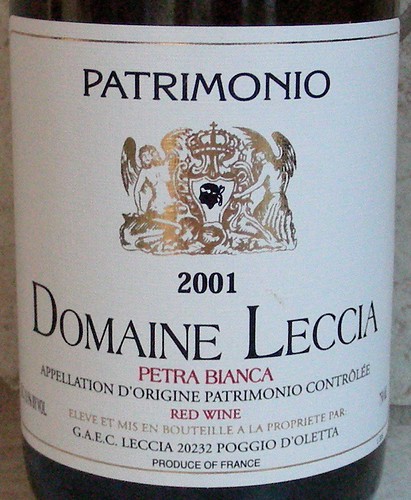
Palombaggia beach
Not far from Bastia, Patrimonio is one of Corsica's best wine region. On chalky soil mixed with clay, the vineyard has an exceptional western exposure facing the sea. Surrounding mountains protect the vines from the strong winds coming from the Rhône Valley. The deeply colored Niellucciu — niellu means dark in Corsican — grows particularly well in the area and in Patrimonio, it must account for 95% of red wine. The grape is actually identical to the Tuscan Sangiovese and was most likely imported by Genoese during their rule of the island between the mid 15th century and the late 18th century.
 The 2001 Domaine Leccia Patrimonio Petra Bianca is one of the few Corsican wines that can be found in the United States. It is a Kermit Lynch import that I bought last year at his Berkeley store. It is produced by the Domaine Leccia, a family-owned estate established in 1850. The domaine has a 54 acre vineyard located just a mile away from the sea and planted with traditional varieties such as Niellucciu, Grenache, Malvoisia, and Muscat. It is farmed with no pesticide and the harvest is done manually. Petra Bianca (white stone) is the domaine's special cuvée, made from lots that are particularly rich in limestone and schist.
The 2001 Domaine Leccia Patrimonio Petra Bianca is one of the few Corsican wines that can be found in the United States. It is a Kermit Lynch import that I bought last year at his Berkeley store. It is produced by the Domaine Leccia, a family-owned estate established in 1850. The domaine has a 54 acre vineyard located just a mile away from the sea and planted with traditional varieties such as Niellucciu, Grenache, Malvoisia, and Muscat. It is farmed with no pesticide and the harvest is done manually. Petra Bianca (white stone) is the domaine's special cuvée, made from lots that are particularly rich in limestone and schist.The wine had a dark, brick/brown color. The nose exhibited aromas of sweet blackberries and spices. On the palate, it was full-bodied and well balanced, leaving an aftertaste of bittersweet chocolate. There were also some herbal notes that reminded me of the myrtle berry liqueur, a Corsican specialty that my parents bought one day as a souvenir and that we used to top our crepes with.
Technorati tags: wine food & drink
3 comments:
Mmmmm... Myrtle, mountains and the Mediterranean. I need to go to Corsica!
I'm in a love affair with Corsican wines. A very long-distance one because, as you noted, there aren't many available in North America. In Quebec there are a couple vdp Corsican wines, but I'm after the more traditional AOC wines like Patrimonio and Porto-Vecchio. Maybe I could swap you your Domaine Leccia for the Domaine Torraccia I wrote about here?
I have two bottles of this same wine sitting in my cellar. I'm trying to be patient with them; I've bought/drunk more than a dozen of the Corsican wines that Kermit Lynch brings in (all purchased at his store, too). I'm always happy with these wines, though I think the couple of whites I had really needed a lot more aging than I gave them.
I guess I like Antoine Arena the best, who I think recently changed US distributors (i.e., no longer with Kermit).
I haven't seen any Arena wines here so far. They are supposed to be more powerful than the Domaine Leccia.
I also have a Clos Canarelli Corse Figari that I bought at K&L that I am looing forward to trying it out.
Post a Comment